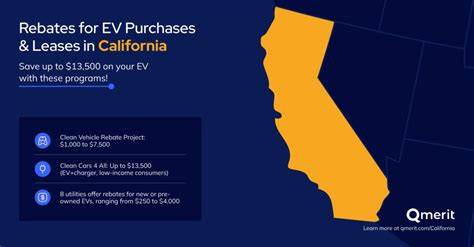California is known for its progressive approach to environmental issues, and the Enhanced Electric Vehicle (EV) Rebate Program is a prime example. Launched to promote cleaner air and encourage sustainable energy use, this program offers financial incentives to residents who make the switch to electric vehicles. Understanding how to navigate this program can significantly ease the transition to a cleaner mode of transport while also providing considerable savings.
The Basics of California’s EV Rebate Program
The Enhanced EV Rebate Program is part of California’s broader initiative to increase the use of electric vehicles. This program offers rebates to consumers who purchase or lease eligible zero-emission vehicles (ZEVs). As part of Governor Gavin Newsom’s aim to have 5 million ZEVs on California roads by 2030, the EV rebate program provides residents with substantial financial benefits.
The rebates vary depending on the vehicle type and the buyer’s income level. For instance, lower-income households may qualify for larger rebates, effectively making EV ownership more accessible to all Californians. The more economical models of electric vehicles are typically incentivized more heavily, encouraging families to adopt greener technologies without breaking the bank.
Benefits of the Program
The benefits extend beyond financial incentives. Here are some advantages associated with the Enhanced EV Rebate Program:
- Financial Incentives: Rebates can range from $2,000 to $7,000, depending on several factors.
- Reduced Fuel Costs: With rising gas prices, the cost of electricity for EVs is often much lower, resulting in significant long-term savings.
- Environmental Impact: Electric vehicles reduce greenhouse gas emissions, contributing to cleaner air and a healthier environment.
- Available Charging Stations: California has numerous public charging stations making it easier to transition from traditional fuel vehicles.
Understanding Eligibility Criteria
Eligibility for the Enhanced EV Rebate Program requires consumers to meet certain criteria:
- The vehicle must be purchased or leased from a California-based dealership.
- The vehicle must be a qualified zero-emission vehicle as defined by the state.
- Applicants must provide proof of California residency.
- Income documentation may be required for higher rebate amounts.
Application Process
The application process for the rebate is straightforward but requires attention to detail. Here’s a step-by-step guide to help you through:
- Choose an Eligible Vehicle: Research and select a zero-emission vehicle that meets your needs.
- Purchase or Lease the Vehicle: Visit your local dealership and complete your transaction.
- Gather Required Documents: This includes proof of residency, vehicle purchase documents, and income proof if applicable.
- Complete the Application: Fill out the state’s online application form carefully, ensuring all information is accurate.
- Submit Application: Send the application along with any required documents electronically, or by mail, depending on the submission guidelines.
- Await Approval: Track your application status online and wait for your rebate determination.
Common Challenges and How to Overcome Them
While the EV Rebate Program offers significant benefits, potential applicants may face challenges. Here are some common issues and tips to overcome them:
- Documentation Issues: Ensuring all documents are complete and accurately reflect your situation is crucial. Double-check all forms before submission.
- Understanding Eligibility: Always refer to the official California EV rebate website for definitive eligibility criteria and vehicle lists.
- Waiting for Rebate Approval: The processing time can vary. Be patient and continue to check your application online for updates.
Maximizing Your Benefits
To make the most of the Enhanced EV Rebate Program, keep the following tips in mind:
- Combine Rebates: Some additional state and local programs can be stacked with the EV rebate for greater savings.
- Consider Used Vehicles: Certain used electric vehicles are eligible for the rebate, making it possible to save even more money.
- Stay Informed: Subscribe to updates about the program to be aware of any changes, new incentives, or expanded eligibility criteria.
Conclusion
California’s Enhanced EV Rebate Program plays a critical role in the state’s efforts to promote sustainable transportation. By understanding the program’s benefits, eligibility requirements, and application processes, residents can easily navigate this initiative and make a significant positive impact on their environment while enjoying financial benefits. As we work collectively toward cleaner air and a sustainable future, embracing electric vehicles is not just an opportunity; it’s a responsibility we all share.
FAQs
1. How much can I receive from the EV Rebate Program?
The rebate amount can vary based on factors such as vehicle model, whether you are a low-income applicant, and other eligibility criteria. Rebates can range from $2,000 to $7,000.
2. Can I apply for a rebate on a used electric vehicle?
Yes, certain used electric vehicles are eligible for rebates under the program, providing additional options for cost savings.
3. How long does it take to receive my rebate?
The processing time can vary but typically takes several weeks. You can check the status of your application online.
4. What documentation do I need to apply for the rebate?
You’ll need proof of residency, vehicle purchase documents, and income documentation if you are applying for a higher rebate.
5. Are there any penalties for submitting incorrect information?
Submitting incorrect information can lead to delays or denial of your application. Always ensure your application is accurate before submission.
Download State Of California Ev Rebate
